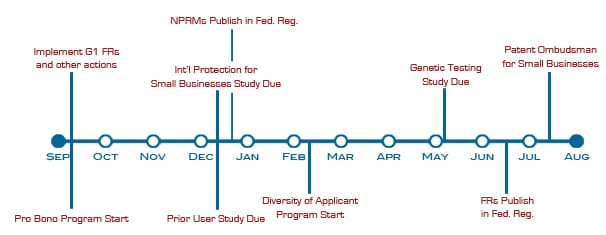Since the America Invents Act has now passed, a lot of applicants will now qualify for a 75% reduction in certain fees at the US Patent Office. The Act created a new micro-entity rate. Now, various fees are due according to the following schedule:
1. Regular applicants: You’re a big boy or girl and you pay full freight. Enough said.
2. Small Entity applicants: you qualify for a 50% reduction in fees, same as before.
3. Micro-Entity applicants (new): you qualify for a 75% reduction in fees, a wholly new class.
Applicants will need to determine — for each and every application — if they qualify for micro-entity status or small entity status, as defined below. The status of applications needs to be determined on a case-by-case basis — and on a continuing basis — since some applications may be licensed or otherwise encumbered such that it is not entitled to micro- or small-entity status.
So, here’s the starting point in the new law:
SEC. 10. FEE SETTING AUTHORITY.
(a) Fee Setting-
(b) Small and Micro Entities- The fees set or adjusted under subsection (a) for filing, searching, examining, issuing, appealing, and maintaining patent applications and patents shall be reduced by 50 percent with respect to the application of such fees to any small entity that qualifies for reduced fees under section 41(h)(1) of title 35, United States Code, and shall be reduced by 75 percent with respect to the application of such fees to any micro entity as defined in section 123 of that title (as added by subsection (g) of this section).
Now, to claim the correct status for any particular application, applicants will need to skim all over the U.S. Code to piece together all the necessary definitions.
In general, you need to see if your application falls into one of the two, reduced fee classes of micro- and small-entities.
Micro Entity Status
Sec. 123. Micro entity defined
‘(a) In General- For purposes of this title, the term ‘micro entity’ means an applicant who makes a certification that the applicant–
‘(1) qualifies as a small entity, as defined in regulations issued by the Director;
‘(2) has not been named as an inventor on more than 4 previously filed patent applications, other than applications filed in another country, provisional applications under section 111(b), or international applications filed under the treaty defined in section 351(a) for which the basic national fee under section 41(a) was not paid;
‘(3) did not, in the calendar year preceding the calendar year in which the applicable fee is being paid, have a gross income, as defined in section 61(a) of the Internal Revenue Code of 1986, exceeding 3 times the median household income for that preceding calendar year, as most recently reported by the Bureau of the Census; and
‘(4) has not assigned, granted, or conveyed, and is not under an obligation by contract or law to assign, grant, or convey, a license or other ownership interest in the application concerned to an entity that, in the calendar year preceding the calendar year in which the applicable fee is being paid, had a gross income, as defined in section 61(a) of the Internal Revenue Code of 1986, exceeding 3 times the median household income for that preceding calendar year, as most recently reported by the Bureau of the Census.
…
‘(d) Institutions of Higher Education- For purposes of this section, a micro entity shall include an applicant who certifies that–
‘(1) the applicant’s employer, from which the applicant obtains the majority of the applicant’s income, is an institution of higher education as defined in section 101(a) of the Higher Education Act of 1965; or
‘(2) the applicant has assigned, granted, conveyed, or is under an obligation by contract or law, to assign, grant, or convey, a license or other ownership interest in the particular applications to such an institution of higher education.
Alas, you ask, what constitutes said Institutions of Higher Education? For that, we have to turn to (20 U.S.C. 1001(a)):
Institution of higher education
For purposes of this chapter, other than subchapter IV, the term “institution of higher education” means an educational institution in any State that –
(1) admits as regular students only persons having a certificate of graduation from a school providing secondary education, or the recognized equivalent of such a certificate;
(2) is legally authorized within such State to provide a program of education beyond secondary education;
(3) provides an educational program for which the institution awards a bachelor’s degree or provides not less than a 2-year program that is acceptable for full credit toward such a degree;
(4) is a public or other nonprofit institution; and
(5) is accredited by a nationally recognized accrediting agency or association, or if not so accredited, is an institution that has been granted pre-accreditation status by such an agency or association that has been recognized by the Secretary for the granting of pre-accreditation status, and the Secretary has determined that there is satisfactory assurance that the institution will meet the accreditation standards of such an agency or association within a reasonable time.
(b) Additional institutions included
For purposes of this chapter, other than subchapter IV, the term “institution of higher education” also includes –
(1) any school that provides not less than a 1-year program of training to prepare students for gainful employment in a recognized occupation and that meets the provision of paragraphs (1), (2), (4), and (5) of subsection (a) of this section; and
(2) a public or nonprofit private educational institution in any State that, in lieu of the requirement in subsection (a)(1) of this section, admits as regular students persons who are beyond the age of compulsory school attendance in the State in which the institution is located.
This last section (b) leaves a lot of questions. Looking at paragraph (b)(1), it say “any school that provides not less than a 1-year program of training to prepare students for gainful employment in a recognized occupation.”
Seriously, if you include paragraph (b)(1), why have paragraph (a)(3)? It’s like saying you have to be four feet tall but the definition also includes people that are three feet tall.
What institution is deemed a “school“? I can’t find a legal definition although it usually refers to lower levels of study and not universities, colleges, or other institutions of higher education but it must meet the requirements of paragraphs (1), (2), (4), and (5) of subsection (a). It must mean something different than “educational institution” used in paragraph (a) and paragraph (b)(2).
Would this include a hospital with a nursing program? But the hospital itself is not a school. What about a research institute that functions to provide part of a course curriculum for a college or university?
A karate school could be said to be legally authorized within such State to provide a program of education beyond secondary education and could by accredited by a nationally recognized accrediting agency or association (see Tsuki Bu-Do Kai Martial Arts Society International)
I can think of a lot of different kinds of schools:
- vocational school
- bible school
- painting school
- finishing school
- home school
- old school
- school of hard knocks
You get the idea.
What are your thoughts?







